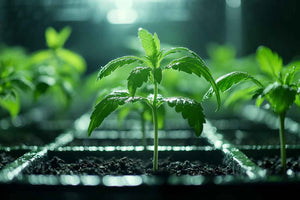Before starting plants cultivation, the first thing you need to confirm is whether it's legal to grow cannabis in your area. You can check this information online. Although cannabis has been legalized in many countries, some places still have strict regulations on the quantity and purpose of cannabis cultivation.
For instance, South Africa now allows private cannabis cultivation, but commercial growing still requires a license.
Once you confirm that cannabis cultivation is permitted in your country, we can move on to discuss the detailed requirements for weed cultivation.
1. How to Choose the Right Cannabis Strain

A good start is half the battle, and selecting the right seeds can lead to a successful growing experience.
Cannabis strains can be broadly divided into three categories: Sativa, Indica, and Hybrids.
- Sativa strains mainly originate from Africa, Central America, and other regions, typically growing between 1-3 meters tall. They are suitable for outdoor cultivation and have energizing effects.
- Indica strains come from the Indian subcontinent and the Middle East, usually growing between 0.5-1.5 meters tall. They are suitable for indoor cultivation and typically have relaxing and calming effects.
- Hybrids are a crossbreed of Sativa and Indica strains, usually growing between 0.5-2 meters tall.
Among them, Sativa strains are native to tropical regions such as Africa, Central America, Southeast Asia, and some parts of South America. They tend to grow taller with thinner leaves and are known for their uplifting effects.
Recommended strains: Northern Lights, Skywalker OG, Silver Haze, Memory Loss, Lemon Meringue.......
Based on your growing environment, goals, and needs, choose the right strain to cultivate. When selecting seeds, consider feminized seeds that appear plump, with a hard shell and a spotted or tiger stripe-like pattern.
2. How to Choose the Right Cultivation Method
Currently, cannabis can be grown indoors or in greenhouses.
Greenhouse cultivation is a semi-enclosed method using plastic films. The advantage is that it can make full use of natural light and reduce the need for grow lights. It can also control the growing environment effectively through the installation of shading nets, fans, etc., making it more cost-effective compared to indoor cultivation.
However, greenhouse cultivation can still be affected by external weather conditions to some extent. Extreme weather can easily damage the plants, and environmental control is not as precise as indoor growing.
Indoor cultivation allows you to completely control the environment, such as lighting, temperature, humidity, and ventilation, without worrying about weather changes. However, the investment may be higher.
If you want to start with small-scale cultivation, consider using an indoor grow tent kit with lights, which is a lower-cost option and allows you to control the environment.
3. How to Choose the Right Grow Light

In indoor or tent cultivation, where sunlight cannot reach the plants, grow lights are needed to simulate sunlight.
During the vegetative stage, cannabis requires 18 hours of light and 6 hours of darkness. In the flowering stage, this needs to be adjusted to 12 hours of light and 12 hours of darkness to promote flower growth.
After determining the plant type (cannabis) and light type (LED grow lights), the next step is to choose the appropriate light size and wattage based on the size of the growing area to ensure even light coverage.
When purchasing grow lights, opt for dimmable LED grow lights, which allow you to adjust light intensity based on different stages of plant growth.
4. How to Choose Soil
Whether you choose soil-based or soilless cultivation, you need to consider these factors: drainage, aeration, nutrients (nitrogen, phosphorus, potassium), and pH value (maintain at 6.0-7.0).
For natural soil,you can use a combination of 30-40% high-quality soil + 30% leaf mold or compost + 20-30% perlite or vermiculite, and an appropriate amount of worm castings.
Soilless growing media mainly include coco coir, perlite, vermiculite, and rock wool. A mix of 70% coco coir and 30% perlite provides adequate drainage while retaining enough moisture and nutrients; or 60% coco coir and 40% vermiculite can increase moisture retention in drier climates.
5. How to Water Your Cannabis

Don’t underestimate the importance of watering. Over-watering or under-watering can lead to yield issues, or worse, the plants may die halfway through the growing process.
-
Over-watering: Prolonged water accumulation in the pot can cause root oxygen deprivation, lead to pathogenic infections, and trigger root rot. Infected roots will turn brown, soften, and rot, preventing the plant from absorbing water and nutrients, leading to yellowing and drooping leaves, and stunted growth.
-
Under-watering: This can cause leaf curling or drooping and nutrient absorption issues, resulting in slow growth.
Before watering, insert your finger 3-5 cm into the soil. If it feels moist, you can delay watering. If the surface is dry, it’s time to water.
Watering is best done in the morning to allow the plant to absorb water during the day and avoid waterlogging at night, which can cause root rot. When watering, ensure that water reaches the roots without excessive accumulation at the bottom of the container. Consider using black grow bags with good drainage and aeration.
Conclusion
Although the requirements for cannabis cultivation may seem complex, they mainly revolve around lighting, temperature, humidity, ventilation, nutrients, water, and soil. As long as these aspects are managed properly, you can expect to harvest a lot of happiness in three to four months.
FAQ:
1. What is the difference between male and female cannabis plants?
In the early flowering stage, check the nodes of the cannabis plant. If there are small ball-shaped pollen sacs and no white, thin pistils, it is a male cannabis plant. Otherwise, it is a female cannabis plant.
2. Can LED grow lights replace sunlight?
For indoor cultivation, full-spectrum LED lights can replicate sunlight to the maximum extent.

